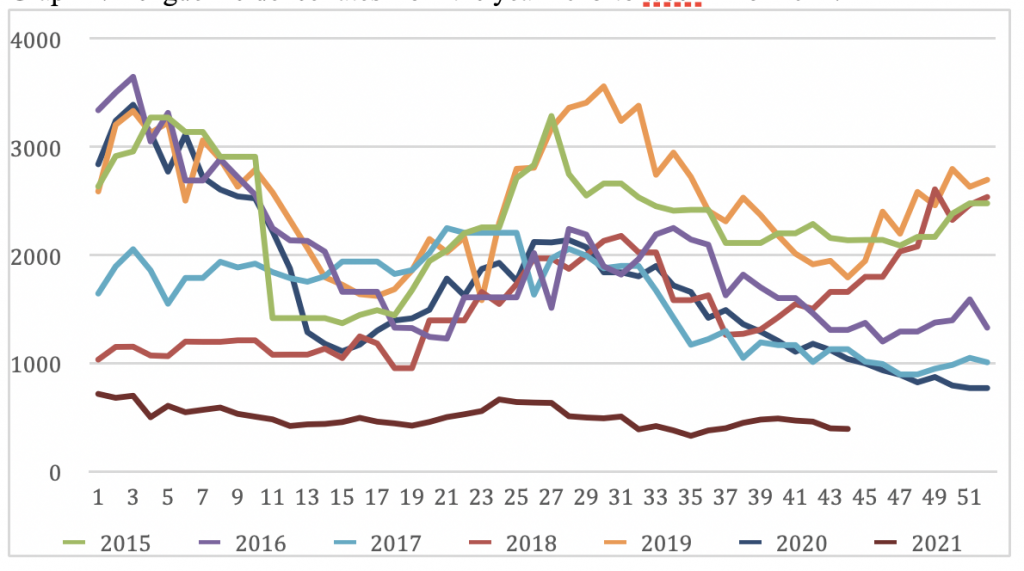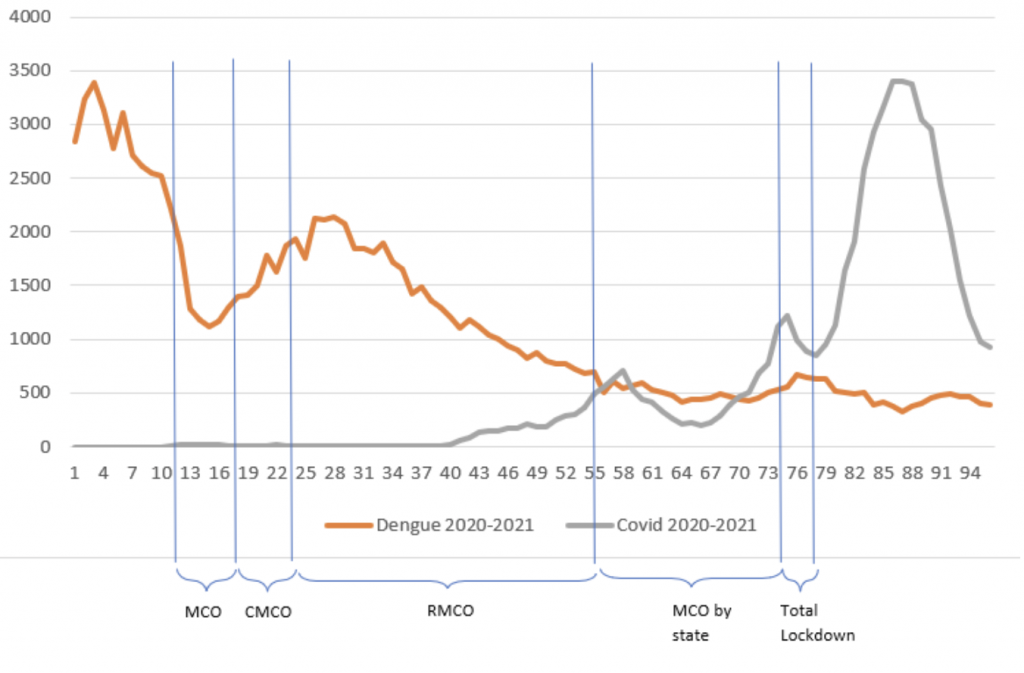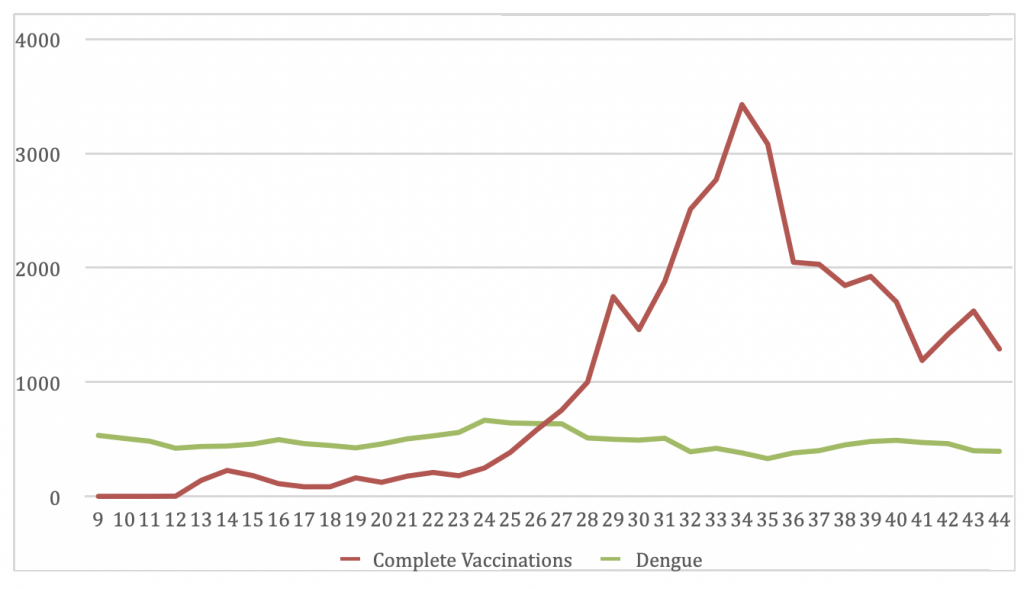
Author: Ze Shan Chan
Mentor: Dr. Rabih Younes
Charterhouse International School
Background
Dengue is a vector-borne, viral infection commonly found in tropical and sub-tropical areas of Central America, South America, Africa, Asia and Oceania [1]. It is caused by 4 types of viruses (DENV-1, DENV-2, DENV-3 and DENV-4), and is spread by the Aedes albopictus and Aedes aegypti species of mosquito, both of which thrive in areas containing standing water like puddles, pails, water tanks and tires [2]. The first dengue case was picked up at Pulau Pinang in 1901, and since then dengue has been a major problem affecting the Malaysian healthcare system and population as a whole for more than a century. By the 1960s, dengue had become endemic and in 1962 the first confirmed case of dengue-haemorrhagic fever was discovered in Pulau Pinang, eventually leading to the first epidemic outbreak in 1973 [3].
The current COVID-19 pandemic and the interventions put forth by the government in response have had their effects on recent dengue incidence rates, particularly in the year 2021. From the epidemiologic weeks 1 to 32 of 2021, a total of 16,565 dengue cases were reported, a drastic decrease of 47,423 (74.1%) from the same period in 2020 [4].
There have been a few different Movement Control Orders (MCO) implemented throughout the period of this study. The first MCO which spanned from 18th March 2020 to 3rd May 2020 [5] contained sanctions for all Malaysians traveling abroad, 14-day quarantines for those returning from overseas [6], general prohibition of mass movements and gatherings including religious, sports, social and cultural activities [6] and the entry of foreign persons into the country [6]. Some specific locations like Simpang Renggam in Johor were subjected to the Enhanced Movement Control Order (EMCO) for 14 days at a time during the period of the first MCO if a large cluster was detected within the area [7]. All residents living in such areas were forbidden from exiting their homes, outsiders were not allowed into the area and all roads into the area were blocked [7]. The Conditional Movement Control Order (CMCO) was implemented from 4th May 2020 to 9th June 2020, and had more relaxed regulations to stimulate the national economy [8]. Most activities and businesses were allowed to operate as long as social distancing was obeyed and interstate travel was not allowed except for work purposes [9]. The Recovery Movement Control Order (RMCO) was implemented from 10th June 2020 to 31st August 2020, and allowed interstate travel outside of areas under EMCO and certain religious activities at mosques [10]. Tourism businesses were allowed to open from 1st July provided that the number of people in crowds was kept to 200-250 people and social distancing measures were obeyed [11]. Private pre-schools, kindergartens and day-care centres were also allowed to operate and many activities such as weddings, seminars, cinemas etc were allowed [12].
This paper examined and analysed the Dengue and COVID-19 incidents more extensively to investigate the reason and the details of this figure, as well as discusses the possible causes of such a drastic decrease.
Objectives
1. To show that the dengue incident rates in Malaysia had behaved unusually and dropped significantly in 2021.
2. To explore the potential contributing factors to the declined dengue incidence rates.
Methodology
This study was conducted during week 44 of 2021, so only data up to that point was used.
In order to illustrate that the dengue incidence rate of 2021 was significant, comparisons with the weekly trend of the Dengue incidence of the previous years was made. The number of reported dengue cases each week starting from week 1 of 2015 to week 44 of 2021 was recorded from public press releases posted on iDengue [13]. Any missing pieces of data were filled by dividing the cumulative number of cases over the number of weeks in the gaps. The epidemiologic weeks were plotted against the dengue incidence rates of each year.
Correlations between COVID-19 incidence rates and dengue incidence rates were explored. Data on COVID-19 incidences per week from 2020 to week 44 of 2021 was retrieved from the Johns Hopkins University COVID-19 data repository. The maximum value from the COVID-19 case data set was divided by the maximum value from the dengue case data set to end up with a value of 44. All COVID-19 incidences per week were then divided by 44 to normalise the data for graph-plotting. The new COVID-19 data was plotted with the dengue incidence rate from 2020 to week 44 of 2021. The periods of the different Movement Control Orders (MCO) were labelled.
Dengue incidence rates during 2021 may have been low due to underreporting: fear of exposure to the COVID-19 virus and the overwhelmed healthcare system are possible reasons. To investigate this, the ratio of positive dengue tests to total number of dengue tests was analysed. This part of the study only covers the city of Ipoh. Dengue NS1 test data was retrieved from Pantai Hospital Ipoh. The data included the total number of negative and positive tests for dengue from 2015 to 2021 in the population of Ipoh. The total number of positive tests from each year was divided by the total number of tests carried out in the respective years to find the positivity rate. The percentage of positive tests for all years were then analysed.
The method of judgement was as follows:
- If the percentage of positive tests was significantly lower than previous years, it was a sign of over testing
- If the percentage of positive tests was significantly higher than previous years, it was a sign of undertesting.
Next, the mortality rates of dengue throughout the years from 2018 to 2021 were analysed. The total number of deaths by dengue each studied year in Malaysia was recorded. The data was taken from the World Health Organizations Dengue Situation Update Number 634 [14]. The results between the years were then compared.
The idea of a correlation between vaccination and dengue incidence rates was also explored inside this study. The cumulative number of full vaccinations (2 doses) for each week from week 9 to week 44 of 2021 in Malaysia was recorded. The data was taken from the University of Oxford’s “Our World in Data” website [15]. Each successive value had been deducted by the previous value in order to find the number of complete vaccinations each week. To normalise the data for graph-plotting purposes, the greatest value of complete vaccinations in a week was divided by the greatest number of dengue cases in a week. The value that came out was 666. All values of complete vaccinations each week were then divided by 666 and plotted with the dengue incidence rate of the corresponding weeks.
Results

Graph 1 shows clearly that the dengue incidence rates of 2021 stray far from the trends of the previous years, behaving entirely differently. The most obvious observation is that the number of cases in 2021 appears to be significantly lower than the previous years, with very little deviance from an approximate range of 300-500 cases. Dengue cases usually rise in the months of June to August (week 23 to week 32), and November to February (week 43 to week 60), during the monsoon seasons, as it leaves many areas with standing water which mosquitoes can thrive in [16]. However, dengue incidences in 2021 do not seem to follow this trend which has been consistent for all past years, pointing towards 2021 being highly unusual.

Graph 2 shows that dengue incidence rates had begun to decrease continuously around the same time as the beginning of the increase in COVID-19 cases. This could indicate a possible correlation between the two, but more investigation and study is required in order to make any conclusions. During March to June, there is a drop in dengue cases compared to earlier years that is not far from the previous years, but the MCOs contribute to the progressive drop of dengue incidence. Besides that, there does not appear to be much correlation between dengue incidence rates and COVID-19.
| 2015 Count | 2016 Count | 2017 Count | 2018 Count | 2019 Count | 2020 Count | 2021 Count | |
| Total Number of Tests | 4013 | 3327 | 3251 | 2809 | 2752 | 1845 | 614 |
| Total Number of Positive tests | 620 | 260 | 215 | 74 | 133 | 99 | 7 |
| Percentage of positive tests (%) | 15.4 | 7.81 | 6.61 | 2.63 | 4.83 | 5.37 | 1.16 |
There was a general decrease in percentage of positive tests from 2015 to 2018. The rates then increased in the years of 2019 and 2020 then decreased to 1.16% in 2021. It should be noted that the total number of tests done in 2021 was only 614, which is a 79.9% decrease from the average of the past years (2999.5). The low percentage of positive tests shows that undertesting was unlikely. This suggests that the low incidence of Dengue during 2021 is unlikely to cause by under detection.
| Year (week 1 to week 45) | Total Cases | Total Deaths | Mortality rate |
| 2018 | 64701 | 111 | 0.172% |
| 2019 | 106660 | 153 | 0.143% |
| 2020 | 81713 | 133 | 0.159% |
| 2021 | 22101 | 17 | 0.0751% |
From Table 2, it can be seen that the total number of cases recorded as well as the total number of recorded deaths were significantly lower than previous years. The total deaths in 2021 were 116 lower than 2020, a decrease of 87.2%. The mortality rate in deaths per 1000 people for 2021 was 0.0751%, drastic decrease from the yearly average of the previous years which was 0.158%.
Mortality rates are a reliable way to visualise real dengue incidence rates, as deaths will always be reported. This method of analysis and the results decrease the possibility of underreporting being the cause of such low recorded incidence rates. This data points convincingly towards dengue cases dropping in 2021.

Graph 3 reflects no correlation between complete vaccinations and dengue, implying that the COVID-19 vaccinations have no effect on immunity against dengue. Although, majority of COVID-19 vaccinations were only completed near the end of the dengue data recorded, so claiming that there is completely no correlation would not be a reliable conclusion. They may have been a further decrease in dengue cases after week 44. Further study must be done.
Discussion
The data shows unequivocally that there is a significant drop in dengue incidence in the year 2021 compared to previous years, although this decrease seemed to begin around week 30 of 2020. A few speculations were made at an attempt to explain such a decrease. Firstly, one of the possible contributing factors to the decrease was that the cases may have been underreported as the healthcare system may have been overwhelmed, and people who potentially had dengue may have been afraid to seek treatment due to fear of contracting COVID-19 from healthcare facilities. Furthermore, the low dengue mortality rates during 2021 reflects the reduction of dengue incidence, as deaths are less likely to be unreported. The low positive rate of dengue tests and low dengue mortality rate convinced us that the drop of dengue cases in 2021 is unlikely to be caused by under reporting or under detection.
The next hypothesis is that under the movement control orders, people had more time to clean their homes and get rid of potential breeding grounds for vectors. Studies have shown that more frequent cleaning does lead to lower dengue incidence rates [17] [18]. This can only be ascertained with data from a vector (Aedes aegypti and Aedes albopictus) surveillance study.
The restriction on travel might also have affected dengue incidence rates heavily. Previous studies have shown that lesser travel is correlated with lower dengue incidence rates [19]. There have been many travel bans throughout the COVID-19 periods in Malaysia. Further study and analysis of the dengue incidence rates in these time periods is required to draw any conclusions. Unfortunately, month by month data of specific regions was not accessible.
Another potential contributing factor is the closing down of schools and workplaces because of the MCOs and transition to online schooling/working. In 2020, there were 5 million students among the population of 32.37 million in Malaysia [20]. The students were also equally distributed across every household across the nation, making the abstention from schools all the more significant. If this speculation is true, it would prove fruitful to look further into school and working environments as potential reservoirs of Aedes mosquitoes.
The dengue test data collected had two limitations: patient specific data could not be collected and the data only represented the population of Perak. Different trends and conclusions could be made if all test types and a bigger part of the population was included.
The significant drop of dengue cases during the COVID-19 pandemic has generated a plethora of hypotheses that could be made for further investigation. This pandemic and the MCOs implemented in response have led to a natural experiment in which there was a nationwide change of lifestyle in Malaysia. Hence, a lot of opportunities for further research into the control of dengue and other infectious diseases have opened up.
Bibliography
[1] World Health Organization, “Dengue and Severe Dengue,” 10 January 2022. [Online]. Available: https://www.who.int/news-room/fact-sheets/detail/dengue-and-severe-dengue.
[2] Centers for Disease Control and Prevention, “How to Prevent the Spread of the Mosquito that Causes Dengue,” 25 January 2012. [Online]. Available: https://www.cdc.gov/dengue/resources/vectorcontrolsheetdengue.pdf. [Accessed 17 January 2022].
[3] A. Rudnick, “Dengue fever epidemiology in Malaysia, 1901-1980,” ResearchGate, vol. 1, pp. 1269-1272, 1986.
[4] The Star, “Health Minister: Drastic drop in dengue cases in Malaysia this year,” The Star, 7 August 2021. [Online]. Available: https://www.thestar.com.my/news/nation/2021/08/07/health-minister-drastic-drop-in-dengue-cases-in-malaysia-this-year. [Accessed 17 January 2022].
[5] Bernama, “MCO extended another two weeks to May 12 – Muhyiddin,” Bernama, 23 April 2020. [Online]. Available: https://www.bernama.com/en/general/news.php?id=1835248. [Accessed 17 January 2022].
[6] New Straits Times, “Covid-19: Movement Control Order imposed with only essential sectors operating,” New Straits Times, 16 March 2020. [Online]. Available: https://www.nst.com.my/news/nation/2020/03/575177/covid-19-movement-control-order-imposed-only-essential-sectors-operating. [Accessed 17 January 2022].
[7] N. S. Sham, “COVID-19: PKPD dikuat kuasa di dua kawasan di Simpang Renggam,” Astro Awani, 26 March 2020. [Online]. Available: https://www.astroawani.com/berita-malaysia/covid19-pkpd-dikuat-kuasa-di-dua-kawasan-di-simpang-renggam-235454. [Accessed 17 January 2022].
[8] Bernama, “Perintah Kawalan Pergerakan bersyarat akan dilaksana – Muhyiddin,” Bernama, 1 May 2020. [Online]. Available: https://www.bernama.com/bm/news.php?id=1837419. [Accessed 29 January 2022].
[9] Bernama, “Essence of conditional Movement Control Order,” Bernama, 1 May 2020. [Online]. Available: https://web.archive.org/web/20200502065534/https://www.bernama.com/en/general/news.php?id=1837487. [Accessed 29 January 2022].
[10] The Sun, “Interstate travel among activities allowed from Wednesday – Muhyiddin,” The Sun , 7 June 2020. [Online]. Available: https://web.archive.org/web/20200608041411/https://www.thesundaily.my/home/interstate-travel-among-activities-allowed-from-wednesday-muhyiddin-HN2539119. [Accessed 29 January 2022].
[11] C. Loo, “More sectors to be reopened under RMCO from July 1,” The Sun, 26 June 2020. [Online]. Available: https://web.archive.org/web/20200626081436/https://www.thesundaily.my/covid-19/more-sectors-to-be-reopened-under-rmco-from-july-1-YD2630375. [Accessed 29 January 2022].
[12] The Sun, “Pre-schools, kindergartens to open on Wednesday, preparations underway for the little ones,” The Sun, 29 June 2020. [Online]. Available: https://web.archive.org/web/20200629010541/https://www.thesundaily.my/home/pre-schools-kindergartens-to-open-on-wednesday-preparations-underway-for-the-little-ones-AB2636604. [Accessed 29 January 2022].
[13] Menteri Kesihatan Malaysia, “Demam Denggi Dan Chikungkunya,” 2015-2021. [Online]. Available: https://www.moh.gov.my/index.php/database_stores/store_view/17?items=25&page=6. [Accessed 17 January 2022].
[14] World Health Organization, “Update on the Dengue situation in the Western Pacific Region,” World Health Organization, 2 December 2021. [Online]. Available: https://www.who.int/docs/default-source/wpro—documents/emergency/surveillance/dengue/dengue-20211202.pdf?sfvrsn=fc80101d_106. [Accessed 17 January 2022].
[15] E. M. L. R.-G. C. A. C. G. E. O.-O. J. H. B. M. D. B. a. M. R. Hannah Ritchie, “Our World in Data,” University of Oxford, 2021. [Online]. Available: https://ourworldindata.org/covid-vaccinations?country=MYS. [Accessed 17 January 2022].
[16] H.-Y. Y. et.al, “The effects of seasonal climate variability on dengue annual incidence in Hong Kong: A modelling study,” Scientific Reports, vol. 10, 2020.
[17] P. R. B. S. Krishna Prasad Bhandari, “Application of GIS Modelling for Dengue Fever Prone Area Based on Socio-Cultural and Environmental Factors,” The International Archives of the Photogrammetry, Remote Sensing and Spatial Information Sciences, vol. 37, no. 8, 2008.
[18] T. Chareonviriyaphap, “Larval habitats and distribution patterns of Aedes aegypti (Linnaeus) and Aedes albopictus (Skuse), in Thailand,” Southeast Asian J Trop Med Public Health, vol. 34, no. 3, pp. 529-535, 2003.
[19] H. H. e. al, “Dengue viruses circulating in Indonesia: A systematic review and phylogenetic analysis of data from five decades,” Reviews in Medical Virology, vol. 29, no. 4, 2019.
[20] The Straits Times, “All 5m students in Malaysia back to school for first time since Covid-19 outbreak,” The Straits Times, 5 April 2021. [Online]. Available: https://www.straitstimes.com/asia/se-asia/all-students-in-malaysia-back-to-school-for-first-time-since-covid-19-outbreak. [Accessed 30 January 2022].
About the author

